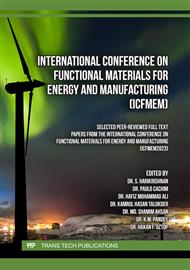[1]
Abbasi, M.A., Din, Q. Under the influence of crowding effects: stability, bifurcation and chaos control for a discrete time predator-prey model, International Journal of Biomathematics, 12(4): 1-35, (2019).
DOI: 10.1142/s179352451950044x
Google Scholar
[2]
Biswas, M.H.A., Pal, A., and Hasan, M.N. Modeling the Potential Impact of Climate Change on the Natural Resources of the Coastal Region of Sundarban Ecosystem in Bangladesh, Proceedings on 17th CTWF September 17-19, 2018 in China CAS-TWAS-WMO Forum, (2018).
Google Scholar
[3]
Biswas, M.H.A., Rahman, T., and Haque, N. Modeling the Potential Impacts of Global Climate Change in Bangladesh: An Optimal Control Approach, J FundamApplSci, 8(1): 1-19, (2016).
Google Scholar
[4]
Iqbal, M.T., & Yasin, S. The role of mathematical modeling in renewable energy technologies. Journal of Renewable and Sustainable Energy Reviews, 75, (2017) 610-620.
Google Scholar
[5]
Raghuvanshi, S.P., Chandra, A., and Raghav, A.K. Carbon Dioxide Emissions from Coal Based Power Generation in India, Energy ConandManagement, 47(6): 427-441 (2006).
DOI: 10.1016/j.enconman.2005.05.007
Google Scholar
[6]
Habib, M.A., and Roy, P.K. Mathematical Modeling Applied to Study the Impact of Climate Change on the Ecology of Plankton, Project Thesis, B.Sc. (Honors), Khulna University, (2018).
Google Scholar
[7]
Kuznetsov, Y.A. Elements of Applied Bifurcation Theory, New York: Springer -Verlag (1997).
Google Scholar
[8]
Kaldellis, J.K., & Zafirakis, D. Applications of artificial neural networks for wind speed prediction in renewable energy systems. Applied Energy, 88(11), 3688-3699 (2011).
Google Scholar
[9]
Muñoz-García, M.A., & Mur-Pérez, F. A review of mathematical models for predicting the power output of wind farms. Renewable and Sustainable Energy Reviews, 60, 923-937 (2016).
Google Scholar
[10]
Matouk, A.E., and Elsadany, A.A. Dynamical analysis, stabilization and discretization of a chaotic fractional–order GLV model, Nonlinear Dynam. 85(3), (2016) 1597–1612.
DOI: 10.1007/s11071-016-2781-6
Google Scholar
[11]
Hassan, K. Nonlinear System, 3rd Edition, Prentice-Hall, Inc., 2002.
Google Scholar
[12]
May, R. Stability and complexity in model ecosystems with a new introduction by the author, Princeton University Press, 1973.
Google Scholar
[13]
Nafeesa, Z., Iqbal, M.T., Iqbal, M.J., Ali, S., & Ullah, H. A review of recent developments in wind energy conversion systems. Journal of Renewable and Sustainable Energy Reviews, 72, 167-182 (2017).
Google Scholar
[14]
Pielou, E.C. An introduction to mathematical ecology, John Wiley and Sons, 1969.
Google Scholar
[15]
Raza, S.M., Sher, F., & Batool, S. Solar energy conversion systems: a review of present status and future prospects. Renewable and Sustainable Energy Reviews, 72, (2017) 1116-1135.
Google Scholar
[16]
Birkhoff, G., Rota, G.S. Ordinary Differential Equations, Ginn, Boston, 1882.
Google Scholar
[17]
Murray, J.D. Mathematical Biology: Biomathematics, Second Edition, Springer, New York, 1989.
Google Scholar
[18]
Singh, A.K., Pandey, K.M., & Pandey, P.C. Renewable energy technology developments in India: A review. Journal of Renewable and Sustainable Energy Reviews, 72, (2017) 62-76.
Google Scholar
[19]
Yang, L., Liu, G., Guo, X., & Zhang, Y. Study on the maximum power point tracking control strategy of photovoltaic system. Journal of Renewable and Sustainable Energy Reviews, 50, (2015) 623-630.
Google Scholar
[20]
Bhandari, B., Poudel, S.R., Lee, K.T., & Ahn, S.H. Mathematical modeling of hybrid renewable energy system: A review on small hydro-solar-wind power generation. International journal of precision engineering and manufacturing-green technology, 1, (2014) 157-173.
DOI: 10.1007/s40684-014-0021-4
Google Scholar
[21]
Martínez-Lucas, G., Sarasúa, J.I., & Sánchez-Fernández, J.Á. Eigen analysis of wind–hydro joint frequency regulation in an isolated power system. International Journal of Electrical Power & Energy Systems, 103, (2018) 511-524.
DOI: 10.1016/j.ijepes.2018.06.028
Google Scholar
[22]
Zhang, Y., & Li, Y. Hydro power generation in China: Current status and prospects. Renewable and Sustainable Energy Reviews, 58, (2016) 122-129.
Google Scholar
[23]
Singh, N.K., & Bachawad, M.R. A review on mathematical modeling of solar, wind and hydro pumped energy storage system. International Journal of Advanced Research in Electrical, Electronics and Instrumentation Engineering, 4(12), (2015) 506-9512.
Google Scholar


